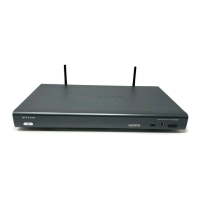5-11
– Keep wireless devices at least two feet from large metal fixtures
such as file cabinets, refrigerators, pipes, metal ceilings,
reinforced concrete, and metal partitions.
– Keep away from large amounts of water such as fish tanks and
water coolers.
• Reduce interference.
Avoid windows unless communicating between buildings.
Place wireless devices away from various electromagnetic noise
sources, especially those in the 2400–2500 MHz frequency band.
Common noise-creating sources are:
– Computers and fax machines (no closer than one foot)
– Copy machines and cell phones (no closer than 6 feet)
– Microwave ovens (no closer than 10 feet)
• Choose your settings.
– Use a scanning utility such as provided in the NETGEAR
wireless adapters to determine what other wireless networks are
operating nearby, and choose an unused channel.
– Turn off SSID Broadcast, and change the default SSID. Other
nearby devices may automatically try to connect to your network
several times a second, which can cause significant performance
reduction.
Optimizing Your Network Bandwidth
As your network grows, it may consist of several segments of different
networking technologies, each providing different throughput. In
planning your network, you should first consider which devices will have
the heaviest traffic flow between them. Examples are:
• A Digital Entertainer HD in one room streaming high-definition
video from a server in another room
• A storage device that is used for backing up your computers
Next, consider the throughput of your network devices. Where possible,
make the heaviest-traffic connections using higher-speed technologies,
with no lower-speed bottlenecks in the path.

